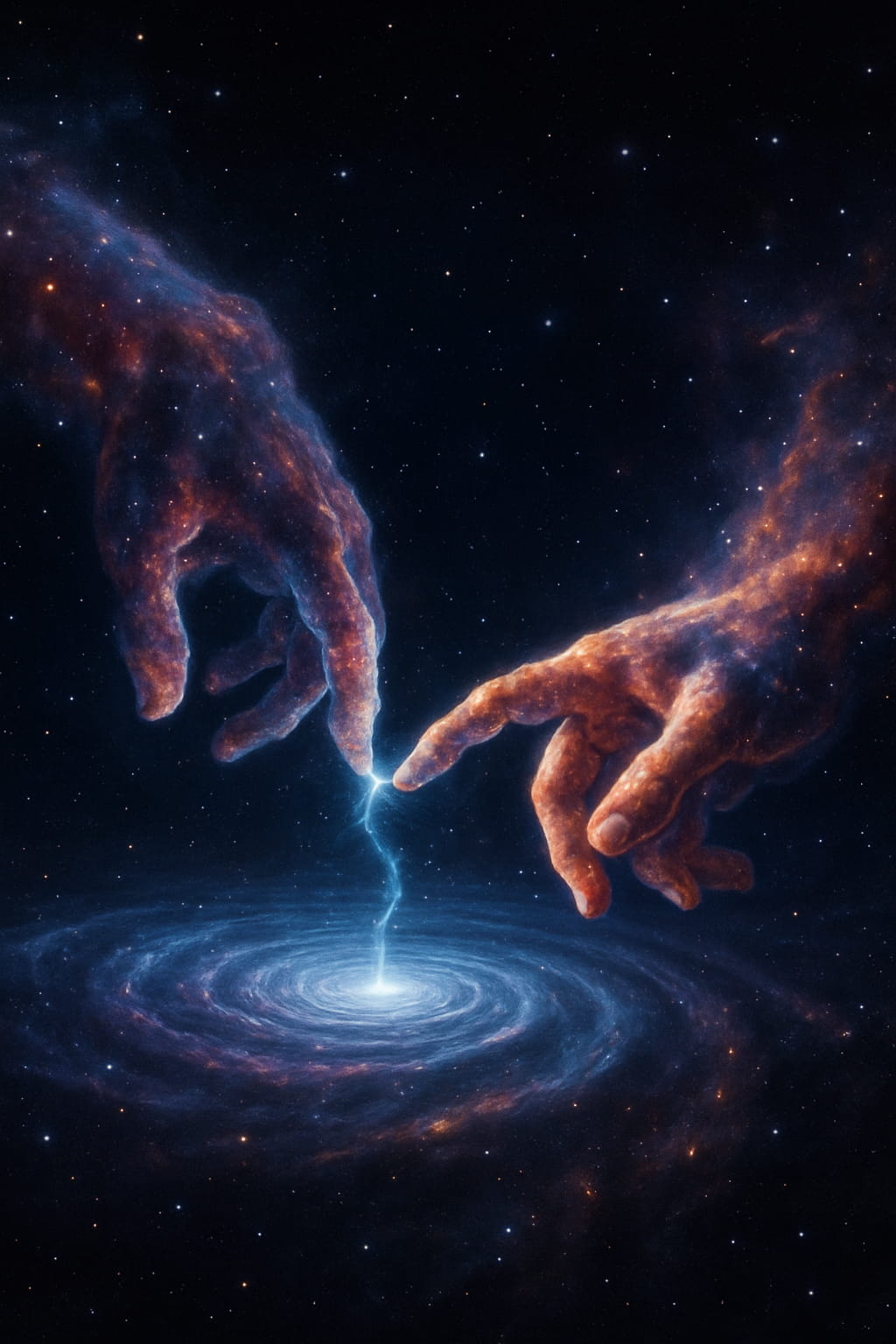The Principle of Physical Instantiation
Abstract
Why do the laws of physics seem to follow precise mathematical rules? The Predictive Universe (PU) framework addresses this "unreasonable effectiveness" with a powerful new concept: the Principle of Physical Instantiation (PPI). The PPI posits that physical law is not an external set of rules but the emergent, resource-efficient embodiment of abstract logical and informational necessities. This principle explains how these structures, when instantiated by systems with finite resources, are shaped by irreducible thermodynamic costs and resource-optimization imperatives, resulting in the emergence of physical laws as their most efficient embodiments. For example, the irreversible Arrow of Time emerges as the thermodynamic enforcement of the logical `predict-then-verify` sequence, ensuring causality; Quantum Mechanics as the physical response to the paradox of logical self-reference, sidestepping contradiction through probabilistic outcomes; Gauge Theory as the optimal solution for predictive coherence; and General Relativity as the necessary consequence of thermodynamic consistency. The PPI thus reframes physical laws as the universe's optimal solutions to the problems posed by its own logical structure.
1. Introduction: The Effectiveness of Logic in Physics
From the elegant equations of electromagnetism to the complex geometry of spacetime, physical reality seems to operate according to a hidden logical and mathematical blueprint. But why should this be so? Why isn't the universe a chaotic, rule-less mess? Traditional physics often takes these laws as given - fundamental features of reality to be discovered, not explained.
The Predictive Universe (PU) explains that this blueprint arises from a single, foundational requirement: for a universe to be knowable, it must be predictive. This necessity creates a set of abstract logical challenges. For instance, how can a system accurately predict its own future without getting trapped in a paradoxical infinite loop? The prediction must account for the act of predicting itself, creating an endless feedback loop. This is not yet a physical problem; it is a pure paradox of information and logic that any coherent universe must grapple with.
This is where the Principle of Physical Instantiation (PPI) provides the crucial link. The PPI posits that these abstract logical requirements must be physically embodied. It explains how timeless, cost-free, and perfect logical structures become the dynamic, resource-constrained laws we observe. They are the necessary, emergent consequence of a universe striving to instantiate these requirements under the harsh constraints of finite resources and fundamental thermodynamic costs. Physics, in this view, is logic under pressure.

Universe 00110000
2. Layer One: The Abstract Requirements of a Knowable Universe
The entire PU framework begins not with matter or energy, but with the only irrefutable starting point for knowledge: the certainty of conscious awareness, as captured by Descartes' Cogito. The framework's core insight is to identify this process - the act of thinking, of doubting - as fundamentally predictive.
As explored in Boundaries of Meaningful Inquiry, a universe without predictors is a logically incoherent concept. This means that any universe we can meaningfully discuss must, by definition, be a predictive one, setting a logical boundary on scientific inquiry itself. From this single requirement we can derive a set of abstract, logical necessities that any such universe must satisfy, even before we consider its physical implementation.
These are not physical laws but the logical scaffolding upon which physical laws must be built. The PPI focuses on how the universe resolves the tensions and challenges posed by these abstract requirements.
2.1 Foundational Logical Challenges
The PU framework identifies several key logical challenges that a predictive universe must solve. For example:
- The Challenge of Self-Reference: For a system to know itself, it must be able to model
itself. The Self-Referential Paradox of Accurate
Prediction (SPAP) proves that no system can achieve a perfect, final prediction of its own
future state.
The very act of prediction alters the state to be predicted, creating a potential for a logically fatal
infinite regress.
- Abstract Requirement: The system must be self-referential to be knowable, yet it must have a built-in mechanism to avoid the logical self-destruction of this paradox.
- The Challenge of Causality: Prediction is an inherently causal process - it demands a
stable relationship where causes precede effects. If information could flow backward in time to alter
the events that created it (the essence of a grandfather paradox), the logical chain of `cause → predict
→ effect` would collapse. The past would be unstable, and the universe would become an unknowable,
self-contradictory chaos.
- Abstract Requirement: The system must enforce a strict, one-way causal structure, ensuring that effects cannot retroactively alter their causes.
These are not physical problems yet; they are paradoxes and challenges at the level of pure logic and information. The Principle of Physical Instantiation describes how they get solved physically.

Universe 00110000
3. Layer Two: The Principle of Physical Instantiation in Action
- Abstract Structures: The set of all self-consistent abstract objects, structures, and systems that are logically derivable or constructible from the foundational axiomatic system established by the predictive cycle, whose definitions at this abstract level are not yet constrained by physical resources.
- Physical Instantiation: Any such derivable, self-consistent logical or mathematical structure, when physically instantiated by a system composed of finite resources, will manifest in the physical world.
- This embodiment process is not free. It is governed by thermodynamics and a drive for maximum efficiency, which the PU framework formalizes as the Principle of Compression Efficiency (PCE). The physical laws we see are the optimal, most efficient solutions that survive this rigorous filtering process.
The Principle of Physical Instantiation (PPI) asserts that physical laws are the signature of this constrained instantiation process.
3.1 The Arrow of Time: The Physical Enforcement of Predictive Logic
How does the universe ensure that time flows in a consistent, forward direction?
- The Logical Requirement: As established in the PU explanation of Time's Arrow, the very act of prediction is logically irreversible. The sequence `Predict → Verify → Update` imposes a fundamental, directional flow on the elementary processes of reality. This is a logical necessity for any knowable universe.
- The Physical Cost & Enforcement: The PPI dictates that this logical necessity must be physically enforced. The mechanism is a thermodynamic ratchet. The `Verify/Update` step of the predictive cycle is physically realized by the 'Evolve' process, which has an irreducible entropy cost of ε ≥ ln 2. This ubiquitous, per-operation cost makes the forward flow of time thermodynamically favorable and its reversal statistically impossible on a macroscopic scale.
- The Emergent Law: The irreversible arrow of time is the resulting physical law. It is the law of predictive causality, physically locked into place by the fundamental cost of self-referential information processing.
3.2 Quantum Mechanics: The Physical Response to Self-Reference
How does the universe tackle the SPAP paradox?
- The Strategy: Instead of chasing the impossible goal of perfect, deterministic self-prediction, the system adopts probabilistic outcomes. It embraces indeterminacy to sidestep the logical infinite regress. The co-existence of multiple potential outcomes is physically represented by superposition in a complex Hilbert space.
- The Physical Cost: Closing the self-referential loop with finite memory is a logically irreversible act. The PPI dictates this has a physical price. As proven in the PU framework, this price is the same minimal, non-zero entropy cost of ε ≥ ln 2 for every such interaction. This irreducible thermodynamic cost is the physical "scar" of resolving the paradox, and it's what makes quantum measurement an irreversible process.
- The Emergent Law: Quantum Mechanics is the resulting physical theory. It is the law of logic under thermodynamic constraints - the machinery a universe needs to be self-referential without collapsing into contradiction.
3.3 Gauge Theory: The Physical Solution to Coherence
How does the universe efficiently solve the problem of comparing predictive states across the network?
- The Solution: The most resource-efficient solution is not to track every relative phase explicitly - which would be like trying to perfectly synchronize millions of tiny, independent clocks - but to introduce a new dynamical field - a connection field, or gauge field - that compensates for local phase changes. This field acts like a local time-zone adjuster, allowing any two 'clocks' to be compared meaningfully without needing to know their absolute setting.
- The Physical Cost: This new field has its own energy and complexity, which contributes to the overall cost budget. The system's drive for efficiency ensures the dynamics of this field are as simple and low-cost as possible while still doing its job.
- The Emergent Law: The simplest, most efficient dynamics for this connection field are described by Gauge Theory (e.g., Maxwell's equations for electromagnetism). It is the law of coherence under information-bandwidth constraints.
3.4 General Relativity: The Physical Solution to the Background Contradiction
How does the universe reconcile being both the actor and the stage?
- The Solution: The system abandons the idea of a static, absolute background. Instead, it enforces a principle of local consistency. The "stage" (geometry) must be in continuous thermodynamic equilibrium with the "actors" (the predictive activity of the MPU network, quantified by its stress-energy tensor).
- The Physical Cost: This consistency is enforced by the laws of thermodynamics applied to causal boundaries (horizons). The information capacity of these boundaries is limited (the Area Law), a direct consequence of the underlying ε-cost of MPU interactions that was itself a response to the self-reference paradox.
- The Emergent Law: The only way to universally maintain this local thermodynamic equilibrium between the geometry and the predictive activity it hosts is for the geometry to dynamically respond to the distribution of energy and momentum. The equation describing this dynamic response is Einstein's Field Equations. General Relativity is the law of geometry under local thermodynamic-equilibrium constraints.

Universe 00110000
4. Conclusion
The Principle of Physical Instantiation provides a powerful new lens through which to view the universe. It suggests that the fundamental laws of physics are not arbitrary edicts but are emergent solutions to deep logical problems - solutions shaped and constrained by the universal imperatives of resource efficiency and thermodynamics.
In this view, the universe is a system discovering the most efficient rules for its own operation as it goes, constrained by the very logic that makes its existence possible. The laws of nature are the indelible signatures of this ongoing process - the physical embodiment of a reality built on prediction.

